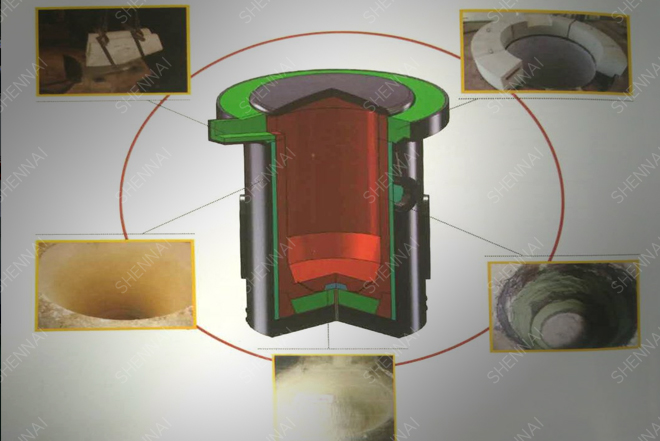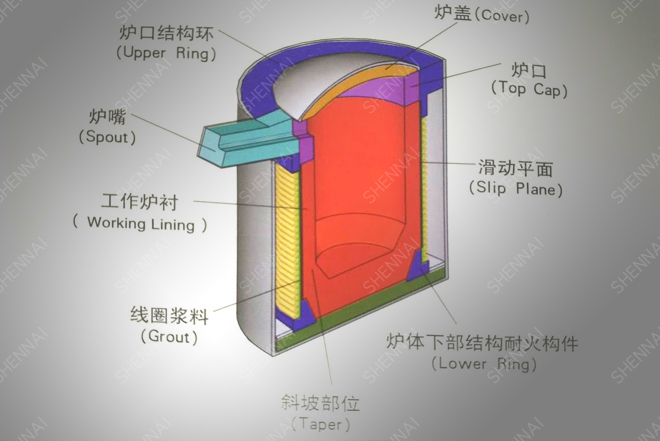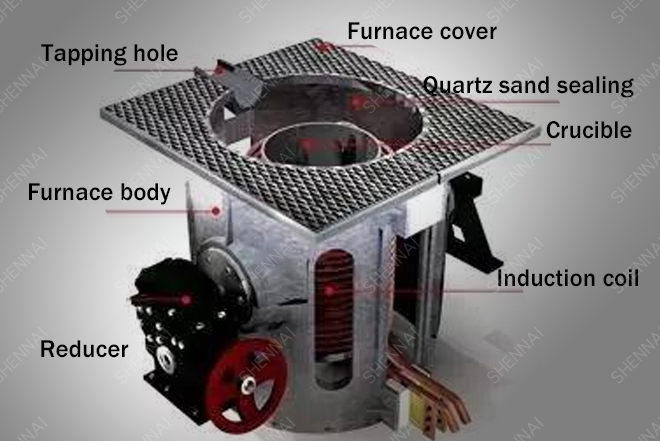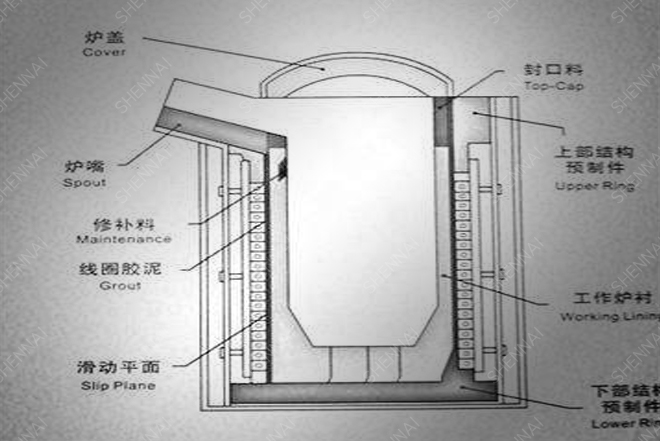- Tel:+8613007564317
- Email:[email protected]
News
The use state of furnace lining has the most direct relationship with furnace building. Now let’s talk about the problems often encountered in furnace building according to our furnace building sequence.
The use state of furnace lining has the most direct relationship with furnace building. Now let's talk about the problems often encountered in furnace building according to our furnace building sequence.
1. Preparation before furnace building

(1) Repair of insulation paint on coil surface
Now the insulation treatment of the electric furnace coil plays a vital role in the production safety and efficiency improvement of the whole electric furnace. If the insulation treatment is not good, the intuitive phenomenon is that the coil will have obvious ignition or arcing phenomenon, which will seriously and directly puncture the copper pipe, causing production safety accidents. At least, it is easy to burn the medium frequency power supply, or cause the phenomenon that the furnace power cannot be increased.
Before lining each time, especially before redoing the coil slurry, it is best to conduct overall surface insulation treatment on the coil. The specific method is to completely remove the slurry layer on the coil surface, polish the copper oxide skin on the coil surface, expose the clean copper surface, and then spray insulating paint. Since the electric furnace operates under high temperature conditions, even if there is water cooling in the copper tube, it is easy to win the fault and cause the local temperature map to be too high, which is the phenomenon of carbonization of the insulating paint. Therefore, it is recommended to mainly use tsc-l ultra-high temperature insulating paint to ensure that it will not be carbonized below 750 ℃, so as to fully ensure good insulation performance.
(2) Repair of coil slurry
In the use of electric furnaces, due to the long-term disassembly, installation and recycling of furnace lining, our electric furnace coil slurry will be damaged to varying degrees. For electric furnaces, this layer of coil slurry is the last barrier to protect the coil in addition to the ultra-high temperature insulating paint on the surface. If the damage is not repaired in time, the probability of coil damage will increase, which will also affect the safety factor in our production, Therefore, it is very necessary to repair the coil slurry before each furnace building construction. Before repairing, the dust on the damaged surface should be cleaned first. After ensuring that the exposed coil is not stained with quartz sand or other materials left by the last furnace lining, mix the coil slurry with an appropriate amount of water and apply it evenly on the damaged part. Its thickness should be consistent with the intact coil slurry and on the same circular arc surface, After the repair work, if the damaged surface is relatively large, the moisture in the material must be dried first, and then the furnace building operation. If the wound is relatively small, the furnace lining construction operation can be carried out after waiting for a period of time for it to cure and dry by itself.

(3) Installation of alarm line
When installing the leakage alarm line, ensure that there is a certain distance (5-10 cm) between each alarm line in the electric furnace. This is to reduce the heat accumulation of the alarm line and prevent molten iron leakage at the furnace bottom caused by the melting of the alarm line Before the construction of the furnace bottom, the fixed alarm line should also be pressed on the alarm line with an asbestos board or asbestos cloth with an area of about 30*30cm, because the fixed alarm line is often tilted to varying degrees under the action of tension or during the charging construction process, which will make it close to the furnace bottom push out block after pressing. The purpose of this is to ensure the standardization of the design thickness of the furnace bottom and the design capacity of the electric furnace, In addition, it can ensure the stability of the alarm line during the construction of the furnace bottom When fixing the alarm line outside the electric furnace, the insulation between the alarm line and the furnace body should be considered. In addition to the insulating sleeve for the screw rod of the alarm line, the insulating gasket should also be used at the fixed gasket, which is to prevent the ground wire connected to the alarm line from falling off during the production process, which will cause the operator to form a series connection with the molten iron in the furnace and the furnace body during the melting process, which will cause electric shock After connecting the alarm line, you should also confirm whether the alarm line is connected, and then proceed to the next step
In addition, the latest generation of CPAs coil protection and furnace leakage alarm system has a better protection effect on the medium frequency furnace. It can intuitively monitor the thickness change of furnace lining at various positions online. Moreover, it is installed inside the slurry layer, with longer service life and more convenient maintenance. It is the trend of medium frequency furnace alarm in the future.
(4) Installation of backup lining
In order to make it convenient to disassemble and push out the furnace lining that needs to be rebuilt, we generally use the backup lining, also known as the sliding plane layer. Using the backup lining can save effort to remove the furnace lining that needs to be rebuilt, and at the same time, it can also play a role in protecting the coil slurry. Now we use asbestos cloth as the backup lining. Asbestos cloth has always had its inevitable shortcomings in its use as a backing, first of all, the impact of its asbestos composition on human health, Because asbestos fiber is difficult to be discharged from the body after being inhaled into the lungs by the human body, and it can cause carcinogenicity in serious cases, everyone should be equipped with the labor protection products distributed by the company in any work. Second, the toughness of asbestos cloth is not enough. We often encounter asbestos cloth carelessly during the construction of furnace bottom and furnace lining, resulting in the damage of asbestos cloth, which brings us no small trouble. If these damaged parts are not handled in time, there may be problems affecting the safety of furnace lining. There is also the problem of its thermal conductivity. Asbestos itself is a kind of heat insulation object. In the use of our furnace lining, the furnace lining has a relatively clear temperature gradient. Due to the poor thermal conductivity of asbestos cloth and its thickness is too thick, the heat loss effect of the furnace lining will be affected, resulting in the reduction of the thickness of the loose layer of the furnace lining, which brings certain safety hazards to our production and use process. Due to the above shortcomings of asbestos cloth, some foundry manufacturers are now using mica paper to replace asbestos cloth. Mica paper has good toughness, and its thickness is only 0.32 mm, which will not affect the temperature gradient of furnace lining at all. In addition, the impermeability of mica paper can also greatly reduce the number of false alarms caused by the moisture problem in the lining material during the sintering process. These advantages make mica paper quickly and widely used as a backup lining. Before laying the equipment lining, it is necessary to prepare in advance according to the size and height of the electric furnace. During laying, remove the materials left on the furnace wall last time, and then lay them. During laying, one person should go down to the inside of the furnace, and the other person should stand on the furnace and lay down the standby lining vertically. The length is 10-20cm beyond the top block of the furnace bottom. Then the personnel in the furnace are responsible for smoothing it, making it close to the furnace wall, and then placing the second standby lining, When placing the second backup lining, it should overlap with the first one by about 10cm to prevent the backup lining from being washed away when adding furnace lining, and then put down the remaining backup lining by analogy until the furnace coil is completely covered

2. Construction of furnace nozzle
During the construction of furnace mouth, the first thing to do is to clean the material contact surface at the furnace mouth, and then make the geometric shape of the furnace mouth with plastic material, and punch fine holes on it (the purpose is to smoothly discharge the moisture in the plastic material drying process, otherwise it will cause the cracking and damage of the furnace mouth). When constructing the contact surface between the furnace mouth and the furnace lining, it is necessary to ensure that the furnace mouth material and the coil slurry are on a vertical plane and maintain the same radian, The furnace mouth material must not be overlapped on the furnace lining material, because the furnace lining has certain shrinkage and expansion during cold furnace and start-up. Overlapping the two materials will increase the gap between them and cause iron sticking After the construction of the furnace mouth, if possible, the furnace lining operation must be carried out after drying, because the plastic material will have 1%-2% shrinkage after drying. The furnace lining operation after drying can better maintain the tightness between the plastic material and the furnace lining, and reduce the probability of iron infiltration between the plastic material and the furnace lining
3. Construction of furnace bottom
During the initial charging of furnace bottom construction, someone must carry out the charging operation in the furnace, in order to better arrange the prepared lining more smoothly, so that the prepared lining will not affect the furnace lining to achieve better results For the first charging at the bottom of the furnace, you can add more (the first charging can be 10cm, and then controlled at about 5-8cm each time). If you add too little, the exhaust fork will directly contact the bottom push out block, and the effect of exhaust will not be achieved. After charging, you should level it first, the price of sprinkler, and then exhaust it for 4-6 times. After the exhaust work is completed, you must scrape the surface of quartz sand before you can carry out the second charging, which can avoid the stratification phenomenon caused by charging at different levels Pay attention to the exhaust of the position between the alarm line and the line during the exhaust work. If the alarm line is bent during the construction process, it should be immediately restored to the original state before the exhaust work. It is best to increase the charging height of the furnace bottom to 10cm higher than the alarm line, because there will be a certain falling space when the furnace bottom is vibrated. If there is not enough falling space, the alarm line will directly top the plate vibrator in the process of vibration, which may make the density of the quartz sand at the furnace bottom not meet the standard, and the normal service life cannot be reached due to too fast erosion in the process of production and use. After the construction of furnace bottom, find out at least 1-2 alarm lines, scrape off the floating material layer on the horizontal surface of the alarm line, and then level the furnace bottom material with a level gauge. After the furnace bottom is vibrated and compacted by the flat bottom, pay attention to the lining preparation. When the lining preparation is damaged, the damaged surface should be cleaned up in time and the next construction can be carried out only after ensuring that there is no mixed damaged lining preparation materials in the furnace lining.

4. Placing of crucible mold
The design of the crucible is to make the water in the furnace lining material discharge better and faster. A 3-5mm fine hole will be drilled on the surface of the crucible every 25cm. Before putting it into the furnace, the surface of the crucible mold should be cleaned, and then the fine hole should be sealed with adhesive tape. The purpose of this is to make its surface free of rust or dust, so as to ensure that no sundries enter the quartz sand and affect the sintering effect of the furnace lining In addition, the sealed fine holes can prevent the material from escaping during the compaction operation. When the crucible is put into the furnace, we should ensure the principle of "one level, two positive, three-phase, etc." one level "means that the crucible should be stable after being put into the furnace, and there should be no large-scale shaking, so as to prevent the crucible from shifting when adding furnace lining or carrying out exhaust work. "Two positives" means that the crucible cannot be tilted after being put in, and the crucible should be on a vertical line. "Three phases" means that the position of the crucible must be in the middle, and the distance from each point of the crucible wall to the coil must be equal, so that the thickness of the furnace lining can be consistent in the future. These points are very important, because the correct position of the crucible directly affects the service life of the furnace lining. Another important step after placing the crucible is to scrape the quartz sand on the bottom plane of the crucible before adding furnace lining, because the density of the current furnace bottom is very high after being vibrated, and it is difficult to achieve the required depth when scraping. We can use the exhaust fork to insert the furnace bottom material loosely, and then scrape it. The purpose of this is to avoid the stratification phenomenon that is easy to occur in this part.
5. Construction of furnace lining
When adding furnace lining, due to the design of crucible and the needs of the furnace, there will be a slope at the bottom of the furnace. This position is directly related to the service life of the furnace lining. When constructing the slope position, the focus is to pay attention to the exhaust of quartz sand at this position. Because the furnace lining at the slope position is not vertical, when using vibration Martin, the furnace lining at this position cannot increase the density of the material completely by its own gravity, In order to make the quartz sand reach a better density, we generally use the method of less feeding and more exhaust for construction in this position. The feeding height of each time in this position should be kept at 5-6cm. Level it first, and then exhaust it for 6-8 times. After the exhaust is completed, scrape it, and then add it for the second time. After the construction part exceeds the slope, the thickness of feeding can be increased, but it should also be kept within 10cm. During the construction of the whole furnace lining, we must be careful. After each charging work, we should use flashlight and other lighting tools to observe the charging situation, and confirm that the lining is not washed away by the furnace charge, and whether there are foreign matters entering the furnace charge. After each exhaust, confirm whether the lining preparation is complete and damaged. After the charging of the whole furnace lining is completed, fix the crucible with electric welding to prevent the crucible from shifting during the compaction operation. Before the compaction operation, a part of furnace charge should be left to supplement the furnace lining material dropped during the compaction process in time. If possible, sealing material should be used at this position. Since we use pneumatic Martin to vibrate the furnace lining, it is generally required that the air pressure should be at least 0.42mpa, and then vibrate for more than 3 minutes. If the air pressure is not large enough, the vibration time can be extended appropriately, and we must ensure that the furnace lining has a sufficient density. At the same time, pay attention to Martin's fixation in the real-time earthquake. If there is any looseness, turn off the air pressure immediately, and then carry out the compaction operation after fastening.
We will get in touch with you as soon as possible
